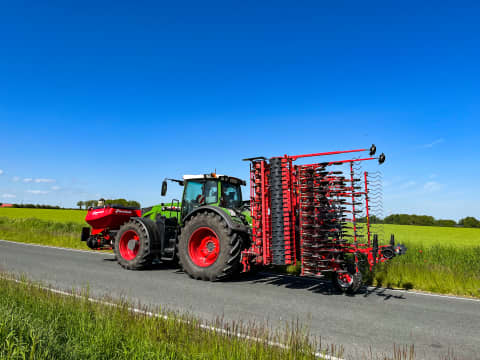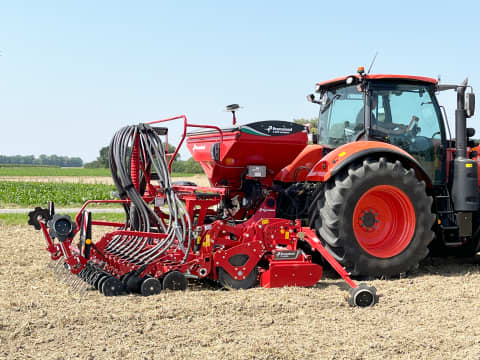Today, Ploughing is the recommended soil preparation method to fight efficiently against: Weeds (Black Grass…), Fungi, Slugs.
1/ Weed Control
Weeds like Black Grass, Ryegrass spray through Europe:
Black Grass |
Ryegrass |
Creeping Thistle |
Weeds display different root systems:
Ploughing controls weeds
Reliance on herbicides alone is not a sustainable strategy. 1 January 2014, the EU Sustainable Use of Pesticides Directive (2009/128/EC). Among the non-chemical methods of plant protection, ploughing is actually recommended.
Source: (Lutman et al., 2013, Weed Research, 53)
Ploughing depth
Scientific studies show that ploughing at 25 cm is an efficient weed control technic.
Table 11.

Source : (Brandsæter et al., 2011, European Journal of Agronomy 34)
Working Width
The correct placing of the weed depends on a ratio between working depth and working width.
„Old school advice“ = 1 : 1,4 ie. 25 cm depth for 35 cm width.
Modern ploughing benefits
Vary-width ploughs & modern bodies enable an optimal furrow slice with a ratio of 1 : 2.
ie. 25 cm depth for 50 cm width with a versatile body like No 28.
Lesser fuel consumption
Kverneland ploughs and bodies will guarantee low pulling forces & a low fuel consumption.
Fuel consumption (l/ha)*
Crop rotation
Weed management integrates a broad range of cultural practices.
Crop rotation is an efficient method when ploughing is carried out once per rotation.
Importance of skimmers
Principle: the skimmer slices off the top soil to place it efficiently at the bottom of the furrow.
A 4 year experiment: (Gummesson and Svensson (1973) Mark-Växter Uppsala) found that continuous use of a plough with a skimmer reduces by 30% the amount of Couch grass (E. repens) compared to ploughing without a skimmer.
Source: European Journal of Agronomy 103 (2019) 54-62. B. Ringselle et al European Journal of Agronomy, 103.
For Docks (Rumex)
At 16cm depth: very few root plants survived ploughing.
At 24 cm ploughing depth with a skimmer: virtually no root plant left, even without a sown crop.
Source: (Ringselle et al., 2019, European Journal of Agronomy, 103).
Easy skimmer adjustments
The Kverneland 2500 i-Plough offers an easy and simultaneous right and left skimmers adjustment.
2/ FUNGUS CONTROL
Lower potential for fungal diseases
Ploughing helps reduce fungal diseases as clearly shown in a study by Kiel University in 2012. Crop rotation combined with ploughing gives the best results.
Reduction of mycotoxine content in soil by more than 80%.
Ploughing helps reduce fungal diseases
3/ SLUGS CONTROL
Most species of slugs are generalists, feeding on a broad spectrum of organic materials, including leaves from living plants.
To prevent their damages, it is important to deprive them from any green cover and all organic matters. Therefore ploughing is an efficient environmental method.

18. February 2019
Sources
BRANDSÆTER, L. O., BAKKEN, A. K., MANGERUD, K., RILEY, H., ELTUN, R. & FYKSE, H. 2011. Effects of tractor weight, wheel placement and depth of ploughing on the infestation of perennial weeds in organically farmed cereals. European Journal of Agronomy, 34, 239-246.
GUMMESON, G. 1973. Tvaskiktsplog och plog med forplog vid bekampning av flyghavre och kvickrot. Lantbrukshögskolans meddelanden 4, 202, Teknik Mark-Växter Uppsala.
HÅKANSSON, I. 2000. Packning av åkermark vid maskindrift. Rapporter från jordbearbetningsavdelningen. Institutionen för markvetenskap, SLU, Uppsala.
LUTMAN, P., MOSS, S., COOK, S. & WELHAM, S. 2013. A review of the effects of crop agronomy on the management of A lopecurus myosuroides. Weed Research, 53, 299-313.
RINGSELLE, B., BERGE, T. W., STOUT, D., BRELAND, T. A., HATCHER, P. E., HAUGLAND, E., KOESLING, M., MANGERUD, K., LUNNAN, T. & BRANDSÆTER, L. O. 2019. Effects of renewal time, taproot cutting, ploughing practice, false seedbed and companion crop on docks (Rumex spp.) when renewing grassland. European Journal of Agronomy, 103, 54-62.


















